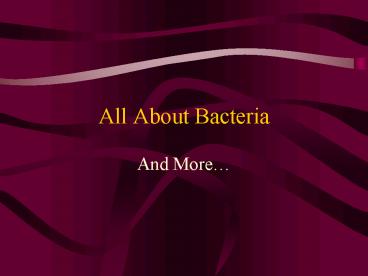All About Bacteria - PowerPoint PPT Presentation
1 / 22
Title:
All About Bacteria
Description:
All About Bacteria And More Important Facts On Bacteria Are prokaryotes they do NOT have a nucleus Have a cell wall Have genetic material (DNA and RNA) Two types ... – PowerPoint PPT presentation
Number of Views:76
Avg rating:3.0/5.0
Title: All About Bacteria
1
All About Bacteria
And More
2
Important Facts On Bacteria
- Are prokaryotesthey do NOT have a nucleus
- Have a cell wall
- Have genetic material (DNA and RNA)
- Two types
- Archaebacteriado not need oxygen to live
- Eubacteriado need oxygen to live
3
Parts of Bacteria
- Cell Membranecontrols what enters and leaves the
cell
- Nucleic AcidsDNA and RNA give instructions to
the cell
- Cell Wallprotects and supports the cell
- Ribosomesproduce proteins
4
More Bacteria Structures
- Flagellumlong whiplike structure that extends
from the cell membrane enabling the bacteria to
move
- Endosporesmall, round, thick-walled, resting
cell that forms inside a bacterial cell when
conditions are not favorable. - Can allow bacteria to live for many years in
extreme conditions - Once the conditions are good again, the endospore
opens up and the bacteria can start multiplying
again
5
Draw, color, label the Bacterial Cell on pg. 64
6
(No Transcript)
7
Archaea
- Once thought to be a primitive life form found
only in the beginning of time.
- Now found in extreme environments such as hot
springs and deep ocean trenches where there is no
oxygen found.
Terms Associated with Archaea
- Anaerobicnot needing oxygen to gain energy (some
bacteria) - Aerobicneeding oxygen to gain energy (some
bacteria and most other organisms)
8
Eubacteria Cell Shapes
9
Reproduction
- Binary Fission
- Conjugation
- Spore Formation
10
Reproduction
- Sexual
- Involves two parents who combine the genetic
material to produce offspring - CONJUGATIONwhen bacteria pass genetic material
through a thin, threadlike bridge that joins the
two cells
- Asexual
- Has only one parent and produces offspring who
are identically identical to the parent - BINARY FISSION
- Involves one parent who divides to form two
identical cells
11
Cellular organism copies its genetic information
then splits into two identical daughter cells
12
Spore Formation Endospore
- A type of dormant cell
- Exhibit no signs of life
- Highly resistant to environmental stresses such
as - -High temperatures
- -Irradiation
- -Strong acids
- -Disinfectants
- Endospores are formed by vegetative cells in
response to environmental signals that indicate a
limiting factor for vegetative growth, such as
exhaustion of an essential nutrient.
13
Louis Pasteur
- Around 1888 - Pasteurization process to kill
germs and prevent disease was invented. - Process includes heating milk at 161 degrees F
for 15 seconds, - inactivating or killing organisms.
14
Alexander Fleming Discovers Penicillin
- 1928 discovered by accident that penicillin
would destroy Staphylococcus - A decade later two scientists isolated the active
ingredient and developed a powdery form of the
medicine to use in treating bacterial infections
during WWII.
15
Questions
- True or False
- Bacteria are prokaryotes.
- Bacteria do not have a cell wall.
- Bacteria have genetic material contained within a
nucleus. - Many bacteria do not need oxygen to live.
16
More Questions
- What is the function of
- the cell wall?
A To protect and support the cell.
- the cell membrane?
A To control what enters and exits a cell.
- the nucleic acids?
A To direct the functions of the cell.
17
Even More Questions
- What are archaea?
A Small, primitive life forms thought to be
extinct.
- What makes them special?
A They are found in many places even though once
thought to be extinct.
- Where are archaea often found?
A Extreme environments such as hot springs and
deep ocean trenches.
- What is the difference between aerobic and
anaerobic respiration?
A Aerobic respiration requires oxygen, and
anaerobic does not.
18
Even More Questions
- Who discovered penicillin?
- A. Alexander Fleming
- Why was this discovery important?
- Prevent the decay of the body or infection from
germs while operating. Prevented many soldiers
from having war wounds becoming infected
19
Critical Thinking
- How are bacteria helpful in general?
20
Helpful Bacteria
- Production of fuel, food, and medications.
- Environmental recycling and clean-up (eat oil
spills or gasoline leaks). - Methane (20 of natural gas deposit) is produced
by bacteria that live in oxygen-free environments
(swamps and lakes). - Bacteria that grow in milk produce cheese, sour
cream, and yogurt. - Some bacteria are decomposers.
- Prevent other harmful bacteria from growing and
they help humans digest their food.
21
What are some ways that bacteria could possibly
help us in the future?
22
Photosynthetic bacteria can capture sunlight
energy at rates 100 times or more greater than
plants, and they do not compete for arable land,"
Rittmann said. This high rate of energy capture
means that renewable biofuels can be generated in
quantities that rival our current use of fossil
fuels.































